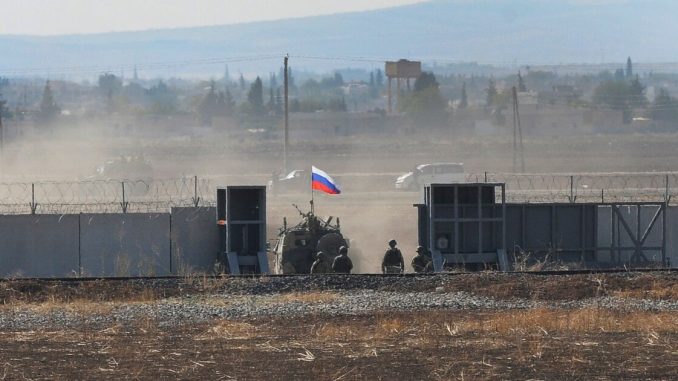
U.S. troops in Syria interact with Russian troops in the region almost every day — and most of the interactions are not contentious, according to Maj. Gen. Kenneth Ekman, deputy commander of Combined Joint Task Force Operation Inherent Resolve.
Despite recent reports of hostile situations, Ekman told reporters Wednesday such scenarios are rare, even though both forces conduct frequent convoys.
“We coexist in some of the same spaces,” Ekman said. “As we do that, we abide by the deconfliction protocols. Whether it’s on the ground or in the air, we see each other all the time.”
The comments come after Brett McGurk, the former special envoy to the counter-ISIS coalition, shared a video on Twitter that appears to depict a confrontation between U.S. and Russian troops in Syria. He tweeted U.S. troops are subjected to harassment from Russian troops on a “daily basis” as he pressed President Donald Trump to “pick up the phone and tell Putin to stop harassing our troops.”
“What you might call harassment, which is, less than absolute professional conduct between the Russians and the U.S., occurs on rare occasions,” Ekman said.
“Our goal is to make sure we abide by the deconfliction protocols, and that we make sure that none of those contacts become escalatory,” Ekman said.
After the U.S. announced it was cutting down on the number of troops it has in Syria last fall, Russia has stepped in and upped its presence there. Politico also reported in June that Russian troops are increasingly getting closer to U.S. troops in Syria as part of an effort aimed at pushing out U.S. troops from Syria.
/arc-anglerfish-arc2-prod-mco.s3.amazonaws.com/public/DJIR5H4EK5CCDEWYFXDKX4EYAU.jpg)
While a “residual presence” of ISIS is keeping U.S. troops in Syria, Ekman said that the organization has been “reduced to a low-level insurgency.”
“They struggle just to find sanctuary in rural locations,” Ekman said. “Their leadership, their finances, their logistics, their media, are all just shadows of what they used to be. And so for us, one of the signs of success is that Daesh does not and cannot control terrain.”
It’s unclear how many U.S. troops are currently in Syria, and Ekman declined to share specifics. He did disclose that there are 5,200 U.S. troops in Iraq, although those numbers are “subject to discussion” and added that there would be a “slow reduction” of U.S. troops from Iraq.
“You will see some degree of reduction of forces here in Iraq. That’s just what success looks like,” Ekman said.
/cloudfront-us-east-1.images.arcpublishing.com/mco/TBESC3CXLFDCDKP2HTPOPFSN5Q.jpg)
Ekman also emphasized that the purpose of U.S. troop’s presence in Iraq is to defeat ISIS, not to target Iranian-backed militia groups in Iraq such as Kataib Hezbollah who U.S. officials have said are responsible for rocket attacks targeting U.S. troops in Iraq.
That includes a March rocket attack at Camp Taji that killed two U.S. service members. In response, Marine Corps Gen. Kenneth F. McKenzie Jr. and commander of U.S. Central Command said that the U.S. conducted strikes against five five weapons sites affiliated with Iranian-backed militia group Kataib Hezbollah in Iraq.
“With regards to the Iranian militia groups that reside here in Iraq, they are clearly not our focus of CJTFOIR,” Ekman said. “We are here to defeat Daesh.”
Meanwhile, Vice Adm. James Malloy, commander of U.S. Naval Forces in U.S. Central Command, the U.S. Fifth Fleet, and Combined Maritime Forces, has his eye on Iran from a maritime perspective.
For example, 11 vessels with Iran’s Islamic Revolutionary Guard Corps Navy in April“repeatedly conducted dangerous and harassing approaches” of six U.S. warships in the north Arabian Gulf, the Navy said.
Malloy, who said Iranian vessels continue to “act as provocateurs” in maritime settings, said in situations like these he is primarily focused on the intent behind Iran’s actions — even though that can be difficult to decipher at times because of Iranian force’s poor seamanship.
“Sometimes their activities that are provocative in nature are just bad seamanship, and it still poses a threat to our force because it’s bad seamanship,” Malloy said Wednesday during an event with the Middle East Institute.
Despite these recent episodes like the one in April, Malloy isn’t too concerned with the Iranian’s capabilities and is instead focused on Iran’s intentions.
“I can’t think of anything that they do that keeps me up at night,” Malloy said.
“I don’t worry about capability because I know what capability we bring to bear, and it is substantial,” Malloy said.



Be the first to comment